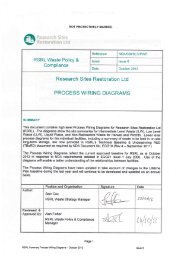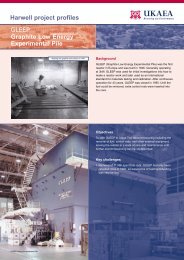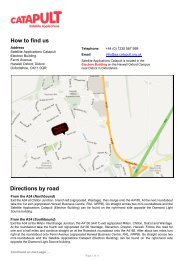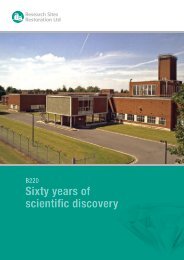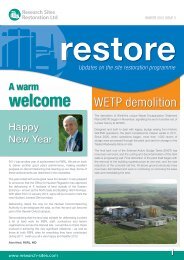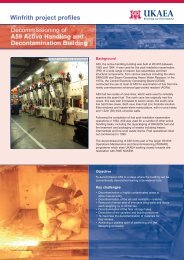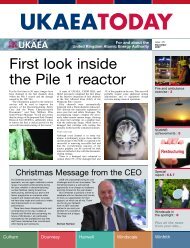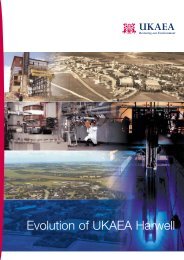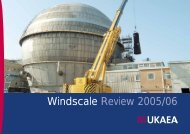RSRL Integrated Waste Strategy - Issue 5- Oct 2012.pdf
RSRL Integrated Waste Strategy - Issue 5- Oct 2012.pdf
RSRL Integrated Waste Strategy - Issue 5- Oct 2012.pdf
You also want an ePaper? Increase the reach of your titles
YUMPU automatically turns print PDFs into web optimized ePapers that Google loves.
NOT PROTECTIVELY MARKED7.2.1.2 Liquid Foul Effluent331. The notionally active (historically) foul effluent is processed through the site sewagetreatment plant which includes settling tanks and bacteria beds to reduce suspended solidsand organic content respectively, before being transferred to the Active Liquid EffluentSystem (ALES) for discharge into the English Channel along with the active effluent throughthe inner pipeline.332. The site waste BPEO Study considered alternative options for the management of theliquid foul effluent including evaporation, filtration and discharge to an off-site commercialplant. However, with the volume of the foul effluent and suspended solids load alreadybeing minimised through application of BPM, it was considered that the current practice ofprior treatment followed by direct discharge via the sea pipeline is the BPEO for thefollowing reasons:• The low specific activity characteristics of the effluent and hence consequential dosesfrom discharges are negligible;• Minimal operator intervention required with current practice and hence minimal on-siteradiological and safety risks;• Environmental impacts are minimal as negligible secondary wastes would beproduced, resource use would be negligible and there would be no requirement fornew plant; this accords with the principles of the National Radioactive Discharge<strong>Strategy</strong>333. Although direct discharge is the current preferred strategy it will be kept under reviewwith regard to changing characteristics of the effluent.7.2.1.3 Active Process Effluent334. The active process effluent waste stream includes the radiologically contaminatedground water from beneath the now demolished Active Handling Complex. This containsvery little activity and most of the problem is with suspended solids.335. The primary radionuclide in the active effluent with respect to dose to the critical group iscaesium-137, whilst in terms of total activity is tritium. No abatement plant currently exists tocontrol the activity of discharges from site. BPM is applied at facility level to ensure that theactivity is controlled at source, rather than relying on treating the effluent once it has beencollected from around the site. The active process effluents are collected in holding tanksand, after treatment through the ALES (analysis of effluent samples and pH correction oftank contents), are discharged to sea under a permit and consents granted by theEnvironment Agency (EA).336. The site waste BPEO Study looked at alternative management options for the activeprocess effluent including ion exchange and filtration. However the high volume of effluentpassing through the ALES system with a relatively high natural ionic content would make ionexchange impractical because of the quantities of resin that would be required to be usedand given the very low radioactive particulate content of the process effluent the detrimentsin terms of having to manage solid wastes from implementing filtration would significantlyoutweigh any benefits.337. However, in order for <strong>RSRL</strong> to meet it’s obligation to use best available techniques tominimise entrained solids in aqueous waste prior to discharge to the environment aprogramme of work to improve the ALES system was undertaken during 2011. Theinstallation of a lamella inclined plate clarifier unit designed to use gravity settling to clarify<strong>RSRL</strong> IWS (<strong>Issue</strong> 5 – <strong>Oct</strong>ober 2012)91




